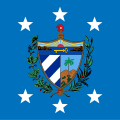Federico Laredo Brú
| Federico Laredo Brú | |
|---|---|
 | |
| 8th President of Cuba | |
|
In office December 24, 1936 – October 10, 1940 | |
| Preceded by | Miguel M. Gómez |
| Succeeded by | Fulgencio Batista |
| Personal details | |
| Born |
April 23, 1875 Remedios, Spanish Cuba |
| Died |
7 July 1946 (aged 71) Havana, Cuba |
| Spouse(s) | Leonor Gomez-Montes |
| Religion | Roman Catholicism |
Dr. Federico Laredo Brú (23 April 1875, Remedios, Las Villas, Cuba – 7 July 1946, Havana, Cuba) was an attorney and served as President of Cuba from 1936 to 1940. He was married to Leonor Gomez-Montes (1880-?).
Rise to power
Laredo's rise to power began in January 1936 as Vice President. When Miguel Mariano Gomez, son of former president José Miguel Gómez won the presidential election, strongman Fulgencio Batista, engineered the impeachment of Gomez in December 1936 for having vetoed a bill to create rural schools under army control. Federico Laredo Brú served the concluding years of Gomez' term leading the way for an ambitious Batista.[1]

Social and economic programs
Under Federico Laredo Brú, amnesties were granted including to the brutal, former dictator Gerardo Machado and the Cuban Congress passed many social welfare measures as well as laws creating pensions, insurance, minimum wages, and limited working hours.
In 1937 Brú pushed for the passage of the Law of Sugar Coordination which organized small farmers into cooperatives and unionized agricultural workers, guaranteed tenant farmers a share of their crop and were not to be deprived of their fields if they worked them.
Brú also issued a decree that stated all businesses should be headed by Cuban nationals. Workers unionized, particularly into the Confederation of Cuban Workers, a union in which Communists had substantial influence.[2]
Cuban-U.S. relations
Though the United States had been a dominant force in Cuban politics since 1898 causing anti-American sentiment among the educated, the U.S. presence was lessened under Brú.
SS St. Louis
On May 27, 1939, the ocean liner SS St. Louis arrived, carrying 930 Jewish refugees from Hamburg, Germany fleeing Hitler's persecutions, and was refused permission to land by Brú. Cuban government-issued landing certificates held by the passengers had been shamefully invalidated by Brú's government during their transit. Two persons attempted suicide and dozens more threatened to do the same. Ultimately, only 20-odd refugees were permitted to disembark at Havana and the ship, having likewise failed to enter the US, ultimately disembarked its remaining passengers in England, France, Belgium and the Netherlands.[3][4]
References
- ↑ "Spring Fever". Time Magazine. 1937-04-26. Retrieved 2008-08-14.
- ↑ Historical Text Archive: Cuba 1934-1952
- ↑ Rosen, Robert (2006). Saving the Jews: Franklin D. Roosevelt and the Holocaust. New York, NY: Thunder's Mouth Press. p. 563. ISBN 1-56025-778-4.
- ↑ "The History Place". Retrieved September 18, 2011.
- Otero, Juan Joaquin (1954). Libro De Cuba, Una Enciclopedia Ilustrada Que Abarca Las Artes, Las Letras, Las Ciencias, La Economia, La Politica, La Historia, La Docencia, Y ElProgreso General De La Nacion Cubana — Edicion Conmemorative del Cincuentenario de la Republica de Cuba, 1902–1952. (Spanish)
| Political offices | ||
|---|---|---|
| Preceded by Miguel Mariano Gómez |
President of Cuba 24 December 1936 – 10 October 1940 |
Succeeded by Fulgencio Batista |
